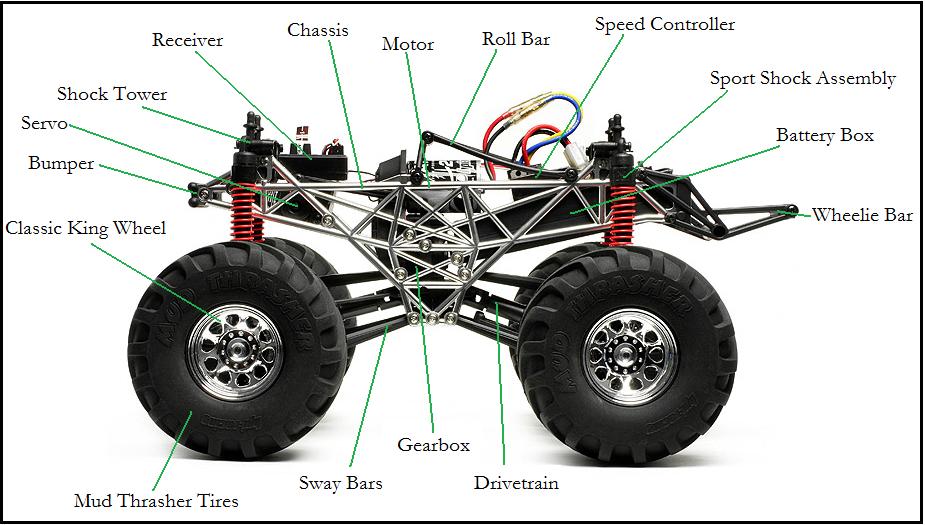R/C Cars
At a basic level, many droids are "just" fancy R/C cars. The typical example is a mouse droid, which is basically an R/C car with a funny top.
Check out the R/C Glossary and Electrical Glossary.
Contents
R/C Car Anatomy
R/C cars are pretty fundamental to many droids. For example, Mouse Droids are pretty much R/C cars with a fancy shell. Many other droids can use an "oversized R/C car" technique. At the very least many of the concepts are similar, even for larger droids.

Mechanical
Mechanically an R/C car has several parts:
- Frame/Chassis
- Everything is attached to the frame, so you need something to stick stuff to!
- Motor
- This is what gets the car moving. R/C car motors are reasonably standardized and come in a variety of powers. Make sure to get one appropriate for your use.
- Gearbox/Transmission
- The motor generally needs geared down to a more reasonable speed, so this is what the gearbox does.
- Driveshaft(s)/Drivetrain
- This gets the spinny power from the transmission to the axle(s). 2WD will have one, 4WD will have two. In R/C cars these usually are two bits that slide over each other so they can stretch or shrink a little as the car moves.
- Differential
- This gets the power from the driveshaft to the axles. Additionally, they usually allow the wheels to move independently so they don't slip on sharp corners. Sometimes for R/C use they're "locked" in which case one wheel will have to slip in a tight turn (because they will be on different radius circles, so they can't spin at the same speed and stay on their circle)
- Axle
- The outer bits from the differential to the wheel. Or on a 2WD car, the front wheel will mount directly to the steering bit.
- Wheel & Tire
- Somewhat obvious. R/C tires are often squishy, and can be glued to the rim to prevent slipping. For heavy droids or certain conditions, the tires will need filled somehow to be rigid enough to support the droid without collapsing.
Suspension:
There is some variability on how R/C cars handle suspensions, but there's also some consistency. The idea of the suspension is usually to keep all 4 wheels on the ground, and to keep the car from shaking to bits from a jump or rough terrain.
- Fixed
- The axles and stuff can just be rigidly attached to the frame. This is seen in cheap kids toys, but might be a viable option for a droid that might always run on a smooth flat show floor.
- Spring
- Most R/C suspensions have springs to allow the wheels to move up and down. They can be different stiffnesses depending on the weight and needs of the vehicle. (eg: racing vs offroad).
- Shocks
- R/C cars also usually have shocks, like real cars. These keep the springs from collapsing or expanding too much. Often these can be selected or adjusted according to the demands of the car.
Electronics
Focusing on electric cars as droids typically aren't gas.
- Transmitter
- Not in the car itself, but this sends the signal to the car.
- Receiver
- Listens to the transmitter, and provides signals to the servos/motors/etc.
- Battery
- Many R/C cars use common 7.4V or 9.6V batteries, though there is a huge selection of batteries available. The voltage/power requirements should be matched with the ESC and motor.
- BEC (Battery Elimination Circuit)
- Since the drive battery is higher voltage than the receiver would like, this is a voltage regulator that provides 5V or 6V power to the receiver and servos. R/C cars have special "BEC" devices, but this is basically "just" a voltage regulator and electronics/robotics parts would work.
- ESC (Electronic Speed Controller)
- This takes power from the battery and a signal from the receiver and provides output to the motor. It should be matched to the motor requirements. Note that often R/C car enthusiasts demand high loads from the system, so these can be overkill for some droids. The concept of this part is similar to a robotics motor controller, and, indeed, some mice use something like a Pololu Simple Motor Controller instead of an R/C ESC.
- Servo(s)
- Servos are used to control things like steering. They plug into the receiver and usually provide a lever or other mechanical motion.
- Electronic Switch
- You can get a switch that listens to an R/C channel and does stuff like turns on or off a car's lights, etc.
Other
And aesthetically you need:
- A shell.
- This is what the car body is, but it's just to be pretty, you don't really need it to drive around. For a mouse, this is a custom part from a few bits and can take a bit of assembly.
- Droid shells are often more involved than R/C car shells, so pay attention, particularly to the weight. You may need to beef up other bits for heavy shells.
Battery Types
Batteries are worthy of their own page!
Transmitters
R/C Transmitters have their own page too!
Glossaries
Resources
Your local hobby shop can probably provide some instruction, there are probably also local R/C enthusiasts near you, and there are online clubs as well. Their focus is typically a little different than ours, they want fast or powerful, vs the long battery life we need in a show.
